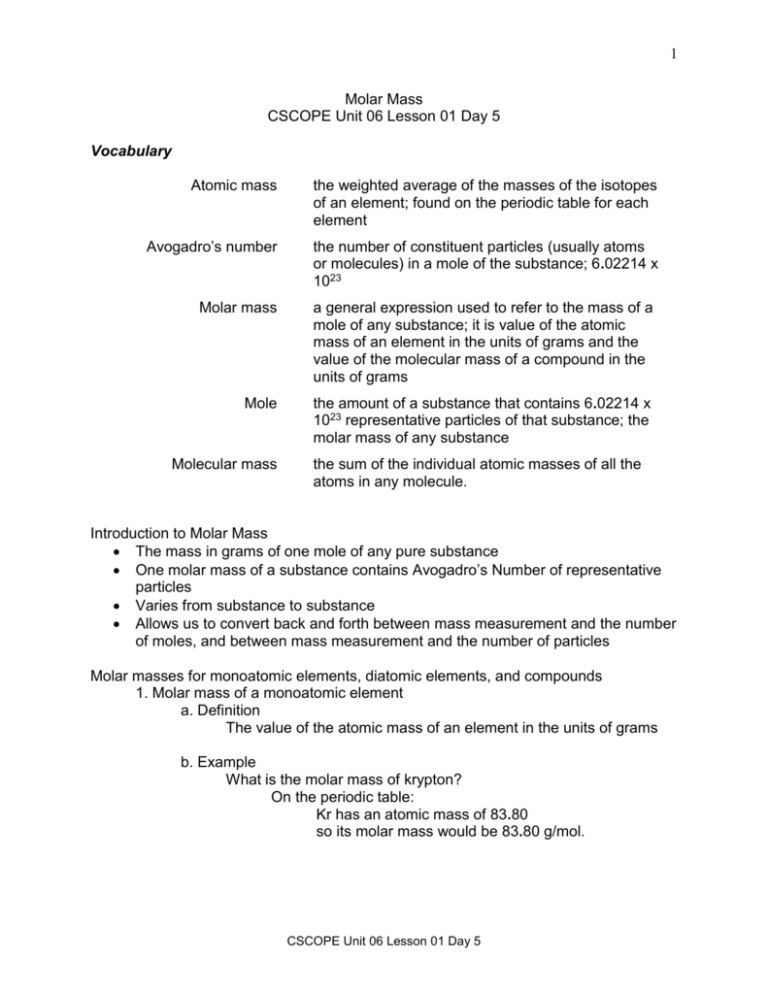UNIT 06 LS 01 Day 5 Molar Mass
advertisement

1 Molar Mass CSCOPE Unit 06 Lesson 01 Day 5 Vocabulary Atomic mass the weighted average of the masses of the isotopes of an element; found on the periodic table for each element Avogadro’s number the number of constituent particles (usually atoms or molecules) in a mole of the substance; 6.02214 x 1023 Molar mass a general expression used to refer to the mass of a mole of any substance; it is value of the atomic mass of an element in the units of grams and the value of the molecular mass of a compound in the units of grams Mole the amount of a substance that contains 6.02214 x 1023 representative particles of that substance; the molar mass of any substance Molecular mass the sum of the individual atomic masses of all the atoms in any molecule. Introduction to Molar Mass The mass in grams of one mole of any pure substance One molar mass of a substance contains Avogadro’s Number of representative particles Varies from substance to substance Allows us to convert back and forth between mass measurement and the number of moles, and between mass measurement and the number of particles Molar masses for monoatomic elements, diatomic elements, and compounds 1. Molar mass of a monoatomic element a. Definition The value of the atomic mass of an element in the units of grams b. Example What is the molar mass of krypton? On the periodic table: Kr has an atomic mass of 83.80 so its molar mass would be 83.80 g/mol. CSCOPE Unit 06 Lesson 01 Day 5 2 2. Molar mass of diatomic elements a. Definition and identification of diatomic elements (1) Definition Elements that normally exist as diatomic molecules (a molecule made up of two identical atoms) (2) There are seven diatomic elements. H2, N2, O2, F2, Cl2, Br2, and I2 Remembering to also include H2, the others form the digit “7” on the periodic table. Or you can use mnemonics: Help Our Needy Class Find Brains Immediately. Have No Fear Of Ice Cold Beer. b. Example What is the molar mass of O2? On the periodic table: O has an atomic mass of 16.00 But, there are two oxygens in one diatomic molecule ! 2 x O = 2 x 16.00 = 32.00 so its molar mass would be 32.00 g/mol. 3. Molar mass of a compound a. Definition The value of the molecular mass of a compound in the units of grams b. Procedure (1) Find the molar mass of each element in the compound. (2) Multiply the molar mass of each element by its subscript in the formula. (3) Add the results together. CSCOPE Unit 06 Lesson 01 Day 5 3 c. Examples What is the molar mass of H2O2? H2O2 has two hydrogens with an atomic mass of 1.01 each and two oxygens with an atomic mass of 16.00 each. Multiplying and converting them to grams gives: 2 x H = 2 x 1.01 g = 2.02 g 2 x O = 2 x 16.00 g = 32.00 g 34.02 g so its molar mass would be 34.02 g/mol. What is the molar mass of (NH4)2O? (NH4)2O has two nitrogens with an atomic mass of 14.01, eight hydrogens with an atomic mass of 1.01 each and one oxygen with an atomic mass of 16.00. Multiplying and converting them to grams gives: 2 x N = 2 x 14.01 g = 28.02 g 8 x H = 8 x 1.01 g = 8.08 g 1 x O = 1 x 16.00 g = 16.00 g 52.10 g so its molar mass would be 52.10 g/mol. Find the molar masses of the following compounds: 1) N2O5 2) lead (II) sulfate CSCOPE Unit 06 Lesson 01 Day 5 4 3) Ca(OH)2 4) dichlorine monooxide 5) (NH4)2CO3 6) diphosphorus tetrachloride 7) (NH4)2S 8) copper (II) acetate CSCOPE Unit 06 Lesson 01 Day 5









